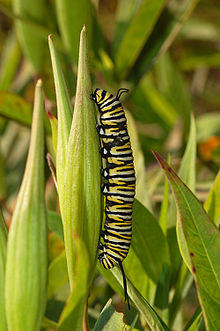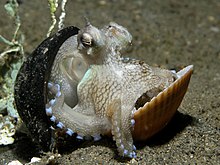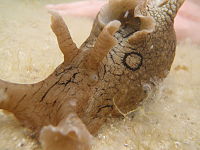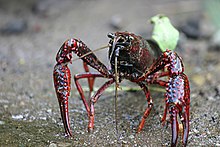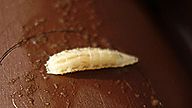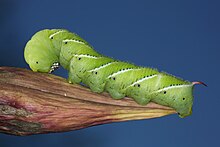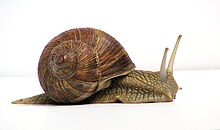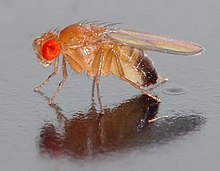A monarch butterfly (Danaus plexippus) caterpillar
Pain in invertebrates is a contentious issue. Although there are numerous definitions of pain, almost all involve two key components. First, nociception is required. This is the ability to detect noxious stimuli which evokes a reflex
response that moves the entire animal, or the affected part of its
body, away from the source of the stimulus. The concept of nociception
does not imply any adverse, subjective feeling; it is a reflex action.
The second component is the experience of "pain" itself, or suffering—i.e., the internal, emotional
interpretation of the nociceptive experience. Pain is therefore a
private, emotional experience. Pain cannot be directly measured in other animals,
including other humans; responses to putatively painful stimuli can be
measured, but not the experience itself. To address this problem when
assessing the capacity of other species to experience pain, argument-by-analogy
is used. This is based on the principle that if a non-human animal's
responses to stimuli are similar to those of humans, it is likely to
have had an analogous experience. It has been argued that if a pin is
stuck in a chimpanzee's
finger and they rapidly withdraw their hand, then argument-by-analogy
implies that like humans, they felt pain. It has been questioned why the
inference does not then follow that a cockroach experiences pain when it writhes after being stuck with a pin. This argument-by-analogy approach to the concept of pain in invertebrates has been followed by others.
The ability to experience nociception has been subject to natural selection
and offers the advantage of reducing further harm to the organism.
While it might be expected therefore that nociception is widespread and
robust, nociception varies across species. For example, the chemical capsaicin is commonly used as a noxious stimulus in experiments with mammals; however, the African naked mole-rat, Heterocephalus glaber, an unusual rodent species that lacks pain-related neuropeptides (e.g., substance P) in cutaneous sensory fibres, shows a unique and remarkable lack of pain-related behaviours to acid and capsaicin. Similarly, capsaicin triggers nociceptors in some invertebrates, but this substance is not noxious to Drosophila melanogaster (the common fruit fly).
Criteria that may indicate a potential for experiencing pain include:
- Has a suitable nervous system and receptors
- Physiological changes to noxious stimuli
- Displays protective motor reactions that might include reduced use of an affected area such as limping, rubbing, holding or autotomy
- Has opioid receptors and shows reduced responses to noxious stimuli when given analgesics and local anaesthetics
- Shows trade-offs between stimulus avoidance and other motivational requirements
- Shows avoidance learning
- Exhibits high cognitive ability and sentience
Suitable nervous system
Central nervous system
Brain size does not necessarily equate to complexity of function. Moreover, weight for body-weight, the cephalopod
brain is in the same size bracket as the vertebrate brain, smaller than
that of birds and mammals, but as big or bigger than most fish brains.
Charles Darwin wrote of the interaction between size and complexity of invertebrate brains:
It is certain that there may be extraordinary activity with an extremely small absolute mass of nervous matter; thus the wonderfully diversified instincts, mental powers, and affections of ants are notorious, yet their cerebral ganglia are not so large as the quarter of a small pin's head. Under this point of view, the brain of an ant is one of the most marvellous atoms of matter in the world, perhaps more so than the brain of man.
Internal anatomy of a spider, showing the central nervous system in blue
Invertebrate nervous systems
are very unlike those of vertebrates and this dissimilarity has
sometimes been used to reject the possibility of a pain experience in
invertebrates. In humans, the neocortex
of the brain has a central role in pain and it has been argued that any
species lacking this structure will therefore be incapable of feeling
pain.
However, it is possible that different structures may be involved in
the pain experience of other animals in the way that, for example, crustacean decapods have vision despite lacking a human visual cortex.
The octopus Amphioctopus marginatus
Two groups of invertebrates have notably complex brains: arthropods (insects, crustaceans, arachnids, and others) and modern cephalopods (octopuses, squid, cuttlefish) and other molluscs.
The brains of arthropods and cephalopods arise from twin parallel nerve
cords that extend through the body of the animal. Arthropods have a
central brain with three divisions and large optic lobes behind each eye for visual processing.
The brains of the modern cephalopods in particular are highly
developed, comparable in complexity to the brains of some vertebrates. Emerging results suggest that a convergent evolutionary process has led to the selection of vertebrate-like neural organization and activity-dependent long-term synaptic plasticity in these invertebrates. Cephalopods stand out by having a central nervous system that shares prime electrophysiological and neuroanatomical features with vertebrates like no other invertebrate taxon.
Nociceptors
Medicinal leech, Hirudo medicinalis
Nociceptors are sensory receptors that respond to potentially damaging stimuli by sending nerve signals to the brain. Although these neurons
in invertebrates may have different pathways and relationships to the
central nervous system than mammalian nociceptors, nociceptive neurons
in invertebrates often fire in response to similar stimuli as mammals,
such as high temperature (40 C or more), low pH, capsaicin, and tissue
damage. The first invertebrate in which a nociceptive cell was
identified was the medicinal leech, Hirudo medicinalis, which has the characteristic segmented body of an Annelida, each segment possessing a ganglion containing the T (touch), P (pressure) and N (noxious) cells.
Later studies on the responses of leech neurones to mechanical,
chemical and thermal stimulation motivated researchers to write "These properties are typical of mammalian polymodal nociceptors".
A sea hare
There have been numerous studies of learning and memory using nociceptors in the sea hare, Aplysia. Many of these have focused on mechanosensory neurons innervating the siphon and having their somata (bulbous end) in the abdominal ganglion
(LE cells). These LE cells display increasing discharge to increasing
pressures, with maximal activation by crushing or tearing stimuli that
cause tissue injury. Therefore, they satisfy accepted definitions of
nociceptors. They also show similarities to vertebrate Aδ nociceptors, including a property apparently unique (among primary afferents) to nociceptors — sensitization
by noxious stimulation. Either pinching or pinning the siphon decreased
the threshold of the LE cells firing and enhanced soma excitability.
Nociceptors have been identified in a wide range of invertebrate species, including annelids, molluscs, nematodes and arthropods.
Physiological changes
In vertebrates, potentially painful stimuli typically produce vegetative modifications such as tachycardia, pupil dilation, defecation, arteriole blood gases, fluid and electrolyte imbalance, and changes in blood flow, respiratory patterns, and endocrine.
The crayfish Procambarus clarkii
At the cellular level, injury or wounding of invertebrates leads to the directed migration and accumulation of haematocytes (defence cells) and neuronal plasticity, much the same as the responses of human patients undergoing surgery or after injury. In one study, heart rate in the crayfish, Procambarus clarkii, decreased following claw autotomy during an aggressive encounter.
Recording physiological changes in invertebrates in response to
noxious stimuli will enhance the findings of behavioural observations
and such studies should be encouraged. However, careful control is
required because physiological changes can occur due to noxious, but
non-pain related events, e.g. cardiac and respiratory activity in
crustaceans is highly sensitive and responds to changes in water level,
various chemicals and activity during aggressive encounters.
Protective motor reactions
Invertebrates show a wide range of protective reactions to putatively painful stimuli. However, even unicellular animals will show protective responses to, for example, extremes of temperature. Many invertebrate protective reactions appear stereotyped and reflexive
in action, perhaps indicating a nociceptive response rather than one of
pain, but other responses are more plastic, especially when competing
with other motivational systems (see section below), indicating a pain
response analogous to that of vertebrates.
Mechanical stimulation
A selection of invertebrates that show avoidance of noxious mechanical stimulation
Rather than a simple withdrawal reflex, the flatworm, Notoplana aticola, displays a locomotory escape behaviour following pin pricks to the posterior end. Touching the larvae of fruit flies, Drosophila melanogaster,
with a probe causes them to pause and move away from the stimulus,
however, stronger mechanical stimulation evokes a more complex
corkscrew-like rolling behaviour, i.e. the response is plastic.
Rather than a simple withdrawal reflex, the flatworm, Notoplana aticola, displays a locomotory escape behaviour following pin pricks to the posterior end. Touching the larvae of fruit flies, Drosophila melanogaster,
with a probe causes them to pause and move away from the stimulus,
however, stronger mechanical stimulation evokes a more complex
corkscrew-like rolling behaviour, i.e. the response is plastic. When a weak tactile stimulus is applied to the siphon of the sea-hare Aplysia californica, the animal rapidly withdraws the siphon between the parapodia. It is sometimes claimed this response is an involuntary reflex (e.g. see Aplysia gill and siphon withdrawal reflex),
however, the complex learning associated with this response (see
'Learned Avoidance' below) suggests this view might be overly
simplistic.
] When a weak tactile stimulus is applied to the siphon of the sea-hare Aplysia californica, the animal rapidly withdraws the siphon between the parapodia. It is sometimes claimed this response is an involuntary reflex (e.g. see Aplysia gill and siphon withdrawal reflex),
however, the complex learning associated with this response (see
'Learned Avoidance' below) suggests this view might be overly
simplistic.
In 2001, Walters and colleagues published a report that described the escape responses of the tobacco hornworm caterpillar (Manduca sexta) to mechanical stimulation. These responses, particularly their plasticity, were remarkably similar to vertebrate escape responses.
A set of defensive behavior patterns in larval Manduca sexta is described and shown to undergo sensitization
following noxious mechanical stimulation. The striking response is a
rapid bending that accurately propels the head towards sharply poking or
pinching stimuli applied to most abdominal segments. The strike is
accompanied by opening of the mandibles and, sometimes, regurgitation.
The strike may function to dislodge small attackers and startle larger
predators. When the same stimuli are applied to anterior segments, the
head is pulled away in a withdrawal response. Noxious stimuli to anterior or posterior
segments can evoke a transient withdrawal (cocking) that precedes a
strike towards the source of stimulation and may function to maximize
the velocity of the strike. More intense noxious stimuli evoke faster,
larger strikes and may also elicit thrashing, which consists of large,
cyclic, side-to-side movements that are not directed at any target.
These are sometimes also associated with low-amplitude quivering cycles.
Striking and thrashing sequences elicited by obvious wounding are
sometimes followed by grooming-like behavior.
Tobacco hornworm larva, Manduca sexta
Autotomy
Over 200 species of invertebrates are capable of using autotomy (self amputation) as an avoidance or protective behaviour including -
These animals can voluntarily shed appendages when necessary for
survival. Autotomy can occur in response to chemical, thermal and
electrical stimulation, but is perhaps most frequently a response to
mechanical stimulation during capture by a predator. Autotomy serves
either to improve the chances of escape or to reduce further damage
occurring to the remainder of the animal such as the spread of a
chemical toxin after being stung, but the 'decision' to shed a limb or
part of a body and the considerable costs incurred by this suggests a
pain response rather than simply a nociceptive reflex.
Thermal stimulation
A heated probe (»42 °C or 108 °F) evokes a complex, corkscrew-like rolling avoidance behaviour in Drosophila larvae which occurs in as little as 0.4 seconds; a non-heated probe does not cause this avoidance behaviour.
In contrast, cold stimuli (≤14°C or 57.2°F) primarily elicit a
bilateral full-body contraction along the head-to-tail axis; larvae
might also respond by lifting their head and/or tail, but these
responses occur less frequently with decreasing temperatures. Land snails show an avoidance response to being placed on a hotplate (»40 °C or 104 °F) by lifting the anterior portion of the extended foot. A 2015 study found that crayfish (Procambarus clarkii) respond adversely to high temperatures, but not to low temperatures.
Chemical stimulation
Crustaceans are known to respond to acids in ways that indicate nociception and/or pain. The prawn Palaemon elegans shows protective motor reactions when their antennae are treated with the irritants acetic acid or sodium hydroxide.
The prawns specifically groom the treated antennae and rub them against
the tank, showing they are aware of the location of the noxious
stimulus on their body rather than exhibiting a generalised response to
stimulation. In Carcinus maenas,
the common shore crab, acetic acid induces a number of behavioral
changes, including movement of the mouthparts, rubbing with the claws,
and increased attempts to escape from an enclosure.
Under natural conditions, orb-weaving spiders (Argiope spp.) undergo autotomy
(self-amputation) if they are stung in a leg by wasps or bees. Under
experimental conditions, when spiders were injected in the leg with bee
or wasp venom, they shed this appendage. But if they are injected with
only saline, they rarely autotomize the leg, indicating it is not the
physical insult or the ingress of fluid per se that causes autotomy. Spiders injected with venom components which cause injected humans to report pain (serotonin, histamine, phospholipase A2 and melittin) autotomize the leg, but if the injections contain venom components which do not cause pain to humans, autotomy does not occur.
Drosophila melanogaster larvae respond to acids and menthol
with a stereotyped nociceptive rolling response, identical to the
behavior seen in response to high-temperature and mechanical insult. The electrophilic chemical allyl isothiocyanate causes nociceptive sensitization in larvae. Adult flies find menthol, AITC, and a number of other chemicals to be aversive, affecting both the proboscis extension reflex and egg-lay site preference.
Acids are also known to activate nociceptors in the nematode Caenorhabditis elegans and in Hirudo medicinalis, commonly known as the medicinal leech.
Electrical stimulation
The sea-slug, Tritonia diomedia, possesses a group of sensory cells, "S-cells", situated in the pleural ganglia, which initiate escape swimming if stimulated by electric shock. Similarly, the mantis shrimp Squilla mantis shows avoidance of electric shocks with a strong tail-flick escape response.
Both these responses appear to be rather fixed and reflexive, however,
other studies indicate a range of invertebrates exhibit considerably
more plastic responses to electric shocks.
Because of their soft bodies, hermit crabs
rely on shells for their survival, but, when they are given small
electric shocks within their shells, they evacuate these. The response,
however, is influenced by the attractiveness of the shell; more
preferred shells are only evacuated when the crabs are given a higher
voltage shock, indicating this is not a simple, reflex behaviour.
In studies on learning and the Aplysia gill and siphon withdrawal reflex, Aplysia received an electric shock on the siphon each time their gill relaxed below a criterion level. Aplysia
learned to keep their gills contracted above the criterion level—an
unlikely outcome if the response was due to a nociceptive experience.
Drosophila feature widely in studies of invertebrate nociception and pain. It has been known since 1974
that these fruit-flies can be trained with sequential presentations of
an odour and electric shock (odour–shock training) and will subsequently
avoid the odour because it predicts something "bad". A similar response has been found in the larvae of this species. In an intriguing study, Drosophila
learned two kinds of prediction regarding a 'traumatic' experience. If
an odour preceded an electric shock during training, it predicted shock
and the flies subsequently avoided it. When the sequence of events
during training was reversed, i.e. odour followed shock, the odour
predicted relief from shock and flies approached it. The authors termed
this latter effect "relief" learning.
Many invertebrate species learn to withdraw from, or alter their
behaviour in response to, a conditioned stimulus when this has been
previously paired with an electric shock—cited by Sherwin—and include snails, leeches, locusts, bees and various marine molluscs.
If vertebrate species are used in studies on protective or motor
behaviour and they respond in similar ways to those described above, it
is usually assumed that the learning process is based on the animal
experiencing a sensation of pain or discomfort from the stimulus, e.g.
an electric shock. Argument-by-analogy suggests an analogous experience
occurs in invertebrates.
Opioid receptors, effects of local anaesthetics or analgesics
In vertebrates, opiates modulate nociception and opioid receptor antagonists, e.g. naloxone
and CTOP, reverse this effect. So, if opiates have similar effects in
invertebrates as vertebrates, they should delay or reduce any protective
response and the opioid antagonist should counteract this. It has been
found that molluscs and insects have opioid binding sites or opioid
general sensitivity. Certainly there are many examples of neuropeptides involved in vertebrate pain responses being found in invertebrates; for example, endorphins have been found in platyhelminthes, molluscs, annelids, crustaceans and insects.
Apart from analgesia, there are other effects of exogenous opiates
specifically being involved in feeding behaviour and activation of
immunocytes.
These latter functions might explain the presence of opioids and opioid
receptors in extremely simple invertebrates and unicellular animals.
Nematodes
Movement of wild-type C. elegans
Nematodes avoid extremes of temperature. Morphine increases the latency of this defensive response in the parasitic Ascaris suum. In a study on the effects of opiates in Caenorhabditis elegans,
76% of a non-treated group exhibited a rapid, reflexive withdrawal to
heat, whereas 47%, 36% and 39% of morphine, endomorphin 1 and
endomorphin 2 treated worms (respectively) withdrew. These effects were
reversed with the opioid receptor antagonists naloxone and CTOP, leading
the authors to conclude that thermonocifensive behaviour in C. elegans was modulated by opioids.
Molluscs
Helix pomatia, a species of land snail
Slugs and snails have an opioid receptor system.
In experiments on different terrestrial snails, morphine prolonged the
latency of the snails' raising their foot in response to being placed on
a hot (40 °C) surface.
The analgesic effects of the morphine were eliminated by naloxone as is
seen in humans and other vertebrates. There was also habituation to
morphine. Snails administered with morphine for four days did not differ
from the control ones in tests on pain sensitivity and analgesia was
achieved only at a higher dose.
Crustaceans
Two crustaceans that show responses to analgesics and their agonists
Evidence of the capacity for invertebrates to experience nociception and pain has been widely studied in crustaceans. In the crab Neohelice granulata, electric shocks delivered via small holes in the carapace
elicited a defensive threat display. Injection of morphine reduced the
crabs' sensitivity to the shock in a dose-dependent manner, with the
effect declining with increasing duration between morphine injection and
shock. Naloxone injection inhibited the effects of morphine, as is seen
in vertebrates. Morphine also had inhibitory effects on the escape tail-flick response to electric shock in the mantis shrimp, Squilla mantis, that was reversed by naloxone, indicating that the effect is found in crustacean groups other than decapods. When the irritants acetic acid or sodium hydroxide were applied to the antennae of grass prawns, Penaeus monodon,
there was an increase in rubbing and grooming of the treated areas
which was not seen if they had previously been treated with a local
anaesthetic, benzocaine,
however, the benzocaine did not eliminate the level of rubbing seen in
response to mechanical stimulation with forceps. There was no effect of
benzocaine on the general locomotion of the prawns, so the reduction in
rubbing and grooming was not simply due to inactivity of the animal. Another local anaesthetic, xylocaine, reduced the stress of eyestalk ablation in female whiteleg shrimps, Litopenaeus vannamei, as indicated by levels of feeding and swimming.
It has not always been possible to replicate these findings in crustaceans. In one study, three decapod crustacean species, Louisiana red swamp crayfish, white shrimp and grass shrimp, were tested for nociceptive behaviour by applying sodium hydroxide, hydrochloric acid,
or benzocaine to the antennae. This caused no change in behaviour in
these three species compared to controls. Animals did not groom the
treated antenna, and there was no difference in movement of treated
individuals and controls. Extracellular recordings of antennal nerves in
the Louisiana red swamp crayfish revealed continual spontaneous
activity, but no neurons that were reliably excited by the application
of sodium hydroxide or hydrochloric acid. The authors concluded there
was no behavioural or physiological evidence that the antennae contained
specialized nociceptors that responded to pH. It could be argued that
differences in the findings between studies may be due to responses to
extreme pH being inconsistently evoked across species.
It has been argued that the analgesic effects of morphine should
not be used as a criterion of the ability of animals, at least
crustaceans, to experience pain. In one study, shore crabs, Carcinus maenas
received electric shocks in a preferred dark shelter but not if they
remained in an unpreferred light area. Analgesia from morphine should
have enhanced movement to the preferred dark area because the crabs
would not have experienced 'pain' from the electric shock. However,
morphine inhibited rather than enhanced this movement, even when no
shock was given. Morphine produced a general effect of
non-responsiveness rather than a specific analgesic effect, which could
also explain previous studies claiming analgesia. However, the
researchers argued that other systems such as the enkephalin or steroid
systems might be used in pain modulation by crustaceans and that
behavioural responses should be considered rather than specific
physiological and morphological features.
Insects
The house cricket, Acheta domestica
Morphine extends the period that crickets remain on the heated surface of a hotplate.
Trade-offs between stimulus avoidance and other motivational requirements
This
is a particularly important criterion for assessing whether an animal
has the capacity to experience pain rather than only nociception.
Nociceptive responses do not require consciousness or higher neural
processing; this results in relatively fixed, reflexive actions.
However, the experience of pain does involve higher neural centres which
also take into account other factors of relevance to the animal, i.e.
competing motivations. This means that a response to the experience of
pain is likely to be more plastic than a nociceptive response when there
are competing factors for the animal to consider.
Hermit crabs fighting over a shell
Robert Elwood and Mirjam Appel at the Queen's University of Belfast
argue that pain may be inferred when the responses to a noxious stimulus
are not reflexive but are traded off against other motivational
requirements, the experience is remembered and the situation is avoided
in the future. They investigated this by giving hermit crabs
small electric shocks within their shells. Only crabs given shocks
evacuated their shells indicating the aversive nature of the stimulus,
but fewer crabs evacuated from a preferred species of shell
demonstrating a motivational trade-off.
Most crabs, however, did not evacuate at the shock level used, but when
these shocked crabs were subsequently offered a new shell, they were
more likely to approach and enter the new shell. They approached the new
shell more quickly, investigated it for a shorter time and used fewer cheliped
probes within the aperture prior to moving in. This demonstrates the
experience of the electric shock altered future behaviour in a manner
consistent with a marked shift in motivation to get a new shell to
replace the one previously occupied.
Learned avoidance
Learning
to avoid a noxious stimulus indicates that prior experience of the
stimulus is remembered by the animal and appropriate action taken in the
future to avoid or reduce potential damage. This type of response is
therefore not the fixed, reflexive action of nociceptive avoidance.
Habituation and sensitization
Habituation and sensitisation are two simple, but widespread, forms of learning. Habituation refers to a type of non-associative learning
in which repeated exposure to a stimulus leads to decreased responding.
Sensitization is another form of learning in which the progressive
amplification of a response follows repeated administrations of a
stimulus.
When a tactile stimulus is applied to the skin of Aplysia californica, the animal withdraws the siphon and gill between the parapodia. This defensive withdrawal, known as the Aplysia gill and siphon withdrawal reflex, has been the subject of much study on learning behaviour.
Generally, these studies have involved only weak, tactile stimulation
and are therefore more relevant to the question of whether invertebrates
can experience nociception, however, some studies have used electric shocks to examine this response (See sections on "Electrical stimulation" and "Operant conditioning").
Other researchers
working with Aplysia were sufficiently impressed by the similarity
between invertebrate and mammalian responses to write:
– Walters, E.T. and Moroz, L.L. (2009)
Persistent nociceptive sensitization of nociceptors in Aplysia displays many functional similarities to alterations in mammalian nociceptors associated with the clinical problem of chronic pain. Moreover, in Aplysia and mammals the same cell signaling pathways trigger persistent enhancement of excitability and synaptic transmission following noxious stimulation, and these highly conserved pathways are also used to induce memory traces in neural circuits of diverse species
Location avoidance
Avoidance learning was examined in the crab Neohelice granulata by placing the animals in a dark compartment of a double-chamber device and allowing them to move towards a light compartment.
Experimental crabs received a shock in the light compartment, whilst
controls did not. After 1 min, both experimental and control crabs were
free to return to the dark compartment. The learned outcome was not a
faster escape response to the stimulus but rather refraining from
re-entering the light compartment. A single trial was enough to
establish an association between light and shock that was detected up to
3 hours later.
Studies on crayfish, Procambarus clarkia, demonstrated
that they learned to associate the turning on of a light with a shock
that was given 10 seconds later. They learned to respond by walking to a
safe area in which the shock was not delivered.
However, this only occurred if the crayfish were facing the area to
which they could retreat to avoid the shock. If they were facing away
from the safe area the animal did not walk but responded to the shock by
a tail-flick escape response. Despite repeated pairings of light and
shock the animals did not learn to avoid the shock by tail-flicking in
response to light. Curiously, when the animals that had experienced
shocks whilst facing away from the safe area were subsequently tested
facing towards the safe area they showed a very rapid avoidance of the
shock upon the onset of the light. Thus, they seemed to have learned the
association although they had not previously used it to avoid the shock
- much like mammalian latent learning. These studies show an ability in decapods that fulfils several criteria for pain experience rather than nociception.
Conditioned suppression
A drone bee
Honeybees extend their proboscis
when learning about novel odours. In one study on this response, bees
learnt to discriminate between two odours, but then learned to suppress
the proboscis extension response when one of the odours was paired with
an electric shock.
This indicates the sensation was aversive to the bee, however, the
response was plastic rather than simply reflexive, indicating pain
rather than nociception.
Operant conditioning
Operant studies
using vertebrates have been conducted for many years. In such studies,
an animal operates or changes some part of the environment to gain a
positive reinforcement
or avoid a negative one. In this way, animals learn from the
consequence of their own actions, i.e. they use an internal predictor.
Operant responses indicate a voluntary act; the animal exerts control
over the frequency or intensity of its responses, making these distinct
from reflexes and complex fixed action patterns.
A number of studies have revealed surprising similarities between
vertebrates and invertebrates in their capacity to use operant responses
to gain positive reinforcements, but also to avoid negative reinforcement that in vertebrates would be described as 'pain'.
Underside of a snail climbing a blade of grass, showing the muscular foot
Snail
It has been
shown that snails will operate a manipulandum to electrically
self-stimulate areas of their brain. Balaban and Maksimova
surgically implanted fine wire electrodes in two regions of the brains
of snails (Helix sp.). To receive electrical stimulation of the brain,
the snail was required to displace the end of a rod. When pressing the
rod delivered self-stimulation to the mesocerebrum (which is involved in
sexual activity) the snails increased the frequency of operating the
manipulandum compared to the baseline spontaneous frequency of
operation. However, when stimulation was delivered to the parietal
ganglion, the snails decreased the frequency of touching the rod
compared to the baseline spontaneous frequency. These increases and
decreases in pressing are positive and negative reinforcement responses
typical of those seen with vertebrates.
Aplysia
To examine the gill and siphon withdrawal response to a putatively painful stimulus, Aplysia
were tested in pairs. During the initial training period, the
experimental animal received a siphon shock each time its gill relaxed
below a criterion level, and the yoked control animal received a shock
whenever the experimental animal did, regardless of its own gill
position. The experimental animals spent more time with their gills
contracted above the criterion level than did the control animals during
each period, demonstrating operant conditioning.
Drosophila
A fly-controlled heat-box has been designed to study operant conditioning in several studies of Drosophila.
Each time a fly walks into the designated half of the tiny dark
chamber, the whole space is heated. As soon as the animal leaves the
punished half, the chamber temperature reverts to normal. After a few
minutes, the animals restrict their movements to one-half of the
chamber, even if the heat is switched off.
A Drosophila flight simulator has been used to examine operant conditioning. The flies are tethered in an apparatus that measures the yaw
torque of their flight attempts and stabilizes movements of the
panorama. The apparatus controls the fly's orientation based on these
attempts. When the apparatus was set up to direct a heat beam on the fly
if it "flew" to certain areas of its panorama, the flies learned to
prefer and avoid certain flight orientations in relation to the
surrounding panorama. The flies "avoided" areas that caused them to
receive heat.
These experiments show that Drosophila can use operant
behaviour and learn to avoid noxious stimuli. However, these responses
were plastic, complex behaviours rather than simple reflex actions,
consistent more with the experience of pain rather than simply
nociception.
Cognitive abilities
Atta colombica workers transporting leaves
It could be argued that a high cognitive ability is not necessary for
the experience of pain, otherwise, it could be argued that humans with
less cognitive capacity have a lower likelihood of experiencing pain.
However, most definitions of pain indicate some degree of cognitive
ability. Several of the learned and operant behaviours described above
indicate that invertebrates have high cognitive abilities. Other
examples include:
- Social transmission of information during the waggle dance of honeybees.
- Idiothetic orientation by spiders, i.e. they memorize information about their previous movements.
- Detour behaviour in which spiders choose to take an indirect route to a goal rather than the most direct route, thereby indicating flexibility in behaviour and route planning, and possibly insight learning.
- Conceptualisation in the honeybee, Apis mellifera.
- Problem solving in leafcutter ants, Atta colombica.
- Numeracy in the yellow mealworm beetle, Tenebrio molitor, and honeybee.
Non-stereotyped behavior
Charles Darwin was interested in worms and "how far they acted consciously, and how much mental power they displayed." In The Formation of Vegetable Mould through the Action of Worms,
Darwin described complex behaviors by worms when plugging their
burrows. He suggested that worms appear to "have the power of acquiring
some notion, however crude, of the shape of an object and of their
burrows" and if so, "they deserve to be called intelligent; for they
then act in nearly the same manner as would a man under similar
circumstances."
Charles Darwin:
One alternative alone is left, namely, that worms, although standing low in the scale of organization, possess some degree of intelligence. This will strike every one as very improbable; but it may be doubted whether we know enough about the nervous system of the lower animals to justify our natural distrust of such a conclusion. With respect to the small size of the cerebral ganglia, we should remember what a mass of inherited knowledge, with some power of adapting means to an end, is crowded into the minute brain of a worker-ant.
Donald Griffin's 1984 Animal Thinking defends the idea that invertebrate behavior is complex, intelligent, and somewhat general. He points to examples in W. S. Bristowe's 1976 The World of Spiders
detailing how spiders respond adaptively to novel conditions. For
instance, a spider can eat a fly held in front of it by an experimenter,
bypassing the usual step of moving toward an insect caught on its web. A
spider may adapt the shape of its web to abnormal circumstances,
suggesting that the web is not just built with a fixed template. Griffin
also considers leaf-cutter ants, with central nervous systems "less
than a millimeter in diameter," and asks: "Can the genetic instructions
stored in such a diminutive central nervous system prescribe all of the
detailed motor actions carried out by one of these ants? Or is it more
plausible to suppose that their DNA programs the development of simple
generalizations [...]?"
In other instances invertebrates display more "dumb," pre-programmed behavior. Darwin himself cites examples involving ants, sphexes, and bees. Dean Wooldridge
described how a sphex wasp brings a paralyzed cricket to its burrow and
then goes inside to inspect the burrow before coming back out and
bringing the cricket in. If the cricket is moved slightly while the wasp
is away making its first inspection, the wasp upon returning from the
burrow reorients the cricket to its proper position and then proceeds to
check the burrow again, even though it was already checked just before.
If the cricket is moved again, the routine repeats once more. This
process has been repeated up to 40 times in a row. Based on this example, Douglas Hofstadter coined the term "sphexish" to mean deterministic or pre-programmed.
Social interaction
Social behavior is widespread in invertebrates, including cockroaches, termites, aphids, thrips, ants, bees, Passalidae, Acari, spiders, and more. Social interaction is particularly salient in eusocial species but applies to other invertebrates as well.
Jeffrey A. Lockwood,
citing previous authors, argues that awareness of how other minds
operate may be an important requirement for social interaction. Social
behavior indicates that insects can recognize information conveyed by
other insects, and this suggests they may also have some self-awareness.
Lockwood asserts: "it is rather implausible to contend that through
sensory mechanisms an insect is aware of the environment, other insects,
and the needs of conspecifics but through some neural blockage, the
same insect is selectively unconscious of sensory input about itself."
Protective legislation
In the UK from 1993 to 2012, the common octopus (Octopus vulgaris) was the only invertebrate protected under the Animals (Scientific Procedures) Act 1986. In 2012, this legislation was extended to include all cephalopods in accordance with a general EU directive
which states "...there is scientific evidence of their [cephalopods]
ability to experience pain, suffering, distress and lasting harm.
